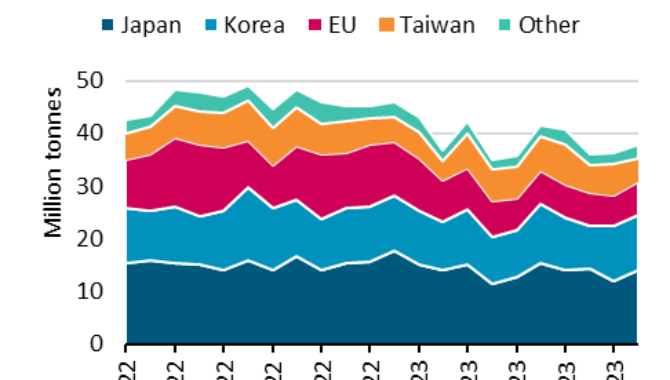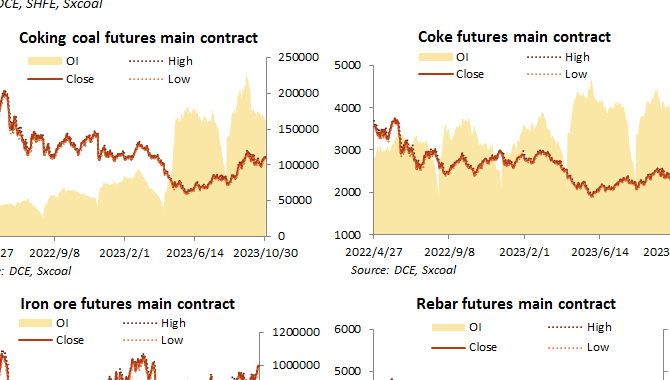
China bought 6 million mt of soy from the US in the first two months of 2020, up 500% year on year as it ramped up purchases under its phase one trade deal commitments, while purchases of Brazilian beans were down 26% to 5.14 million mt, Chinese customs data showed Wednesday.
Under the phase one trade deal, signed on January 15, China committed to purchase $80 billion worth of US agricultural products in two years.
Soybean purchases are a vital aspect of the agreement, since historically the commodity comprises over 50% of annual US agricultural exports to China, while pork, beef and poultry comprise just 5%, 4% and 2%, respectively, according to the US Department of Agriculture.
To further boost the trade agreement, China announced a new round of exclusions for US-origin agro products from the additional tariffs, with soybeans listed as an eligible product for applications by individual importers on February 18.
According to China’s National Grain and Oils Information Center (CNGOIC), as of February 13, China had purchased 12.15 million mt of US soybeans in marketing year 2019-20 (September-August), up from 7.4 million mt during the same period last year.
The Asian nation is expected to import more soybeans in 2020 as it recovers from African swine fever, which began in August 2018 in China and has resulted in a more than 50% reduction of country’s pig population.
According to the Chinese agricultural ministry, pig inventories saw a counter-seasonal increase of 2.8% in February, which is the fifth consecutive month on month increase and takes the total increase to 10% since September.
The recovery from the impacts of ASF will push up protein meal feed use, soybean crush volume and total oilseed demand in the 2020-21 marketing year, the US Department of Agriculture said in its outlook report. The country is the world’s biggest pork producer and consumer and needs high protein soybean-based animal feed to sustain its burgeoning meat industry.
China’s soybean imports are forecast to reach 86 million mt in 2020-21, up 2.4% on the year, based on a recovery in crush volume for animal feed as the swine herd rebuilding continues, the USDA said.
COVID-19 IMPACT
The USDA has not yet factored in the COVID-19 impact on China’s soy purchases, which account for over 60% of global soybean trade.
China’s soybean imports could decline at least in the short term due to the global outbreak of novel coronavirus, market sources said. As the primary soy suppliers, US and Brazil, struggle with the contagion threat, trade union frictions and lockdown issues, the business supply chain has been heavily hit.
Port operations in the Americas are normal currently but there is heavy uncertainty over continued operations in the coming days as the virus spreads.
Chinese analysts expect China to begin its economic recovery starting May, as the infection rate decelerates in the country.
Some market participants have adopted a bullish view on China’s soy purchases in coming months. They expect China to buy more Brazilian beans over the US as the Brazilian harvest season peaks in April.
Chinese crushers still prefer the more price-competitive Brazilian beans over the US-origin, market sources said. Additionally, profitable crush margins have encouraged Chinese soybeans buyers to continue covering their old crop and new crop demand.
Source:Platts
The opinions expressed herein are the author's and not necessarily those of The Xinde Marine News.
Please Contact Us at:
admin@xindemarine.com


 PIL launches Academy to strengthen workforce compet
PIL launches Academy to strengthen workforce compet  Coal shipments to advanced economies down 17% so fa
Coal shipments to advanced economies down 17% so fa  China futures market updates at close (Nov 14)
China futures market updates at close (Nov 14)  CISA: China's daily crude steel output down 5.7% in
CISA: China's daily crude steel output down 5.7% in  China futures market updates at close (Oct 31)
China futures market updates at close (Oct 31)  CISA: China's daily crude steel output down 1.2% in
CISA: China's daily crude steel output down 1.2% in